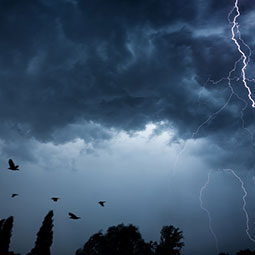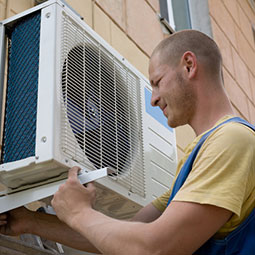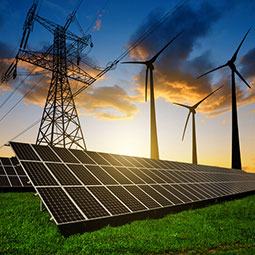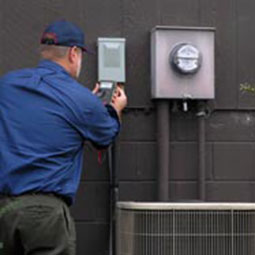Protect Your Business In A Hurricane
Posted on July 19, 2019 at 11:00 AM

Small to medium-sized businesses are typically under prepared for a hurricane and other natural disaster. In fact, 90% of smaller companies fail within a year unless they can resume operations within 5 days, and up to 60% of small businesses never open their doors after a disaster, according to the Federal Emergency Management Agency (FEMA).

Larger companies with the money and manpower dedicate roughly 10 days a month working on continuity plans in the event of a major disaster, FEMA says. Small business owners can mitigate loses and protect employees, too, by investing a little time in planning and preparedness. To get you started, here’s the Pierce Refrigeration Checklist for preparing your HVAC system for a hurricane.
1. Location, location, location.

One of the major hazards in a hurricane is water—specifically, floodwater. Businesses with HVAC equipment located on the roof should be safe from flooding. Wind is the major concern with rooftop units, and there’s more on that below.
Landlords of multifamily properties and businesses located in small buildings and converted residential buildings may have the option to strategically locate heat pumps and air conditioning condensers.
Typically, exterior HVAC equipment is mounted on a concrete slab. For most areas of Massachusetts, this simple foundation works. On the coast and in areas prone to flooding, water levels during a hurricane can easily rise above the thin foundation and flood the heat pump or condenser with water.
To determine how high to elevate your heat pump or condenser to safeguard it in a flood, you can consult a Flood Insurance Rate Map (FIRM) or FEMA’s Flood Map Service Center (https://msc.fema.gov/portal) to find the base flood elevation (BFE) for your area.
✓ Mount your heat pump or A/C condenser at a height of the BFE + 1 foot. Beachfront homes may need a cantilevered platform to mount the heat pump, which FEMA recommends as a solution.
2. Protect against lift and impact.

Hurricane Bob is well known in Massachusetts. It’s one of the top three most-costly hurricanes on record, and it was only a Category 2 hurricane. FEMA doesn’t categorize Cat 2 hurricanes as “major” hurricanes, and still, Bob cost Massachusetts residents $39 million in damages, according to the Massachusetts Office of Coastal Zone Management (CZM).
The takeaway here is: don’t underestimate any hurricane. A Category 2 hurricane, like Bob, has sustained winds of 96–110 mph, according to the Saffir-Simpson Hurricane Wind Scale. In a thriving business area, there are numerous objects that can be a hazard to life and property when hurtling at 110 mph. Restaurants in particular may have trash and ductless mini-split heat pumps in the same tucked-away spot, and all the garbage and trash cans may swirl and batter the equipment for hours.
✓ Clean up the area surrounding your heat pump or A/C condenser of all sticks, branches, and everything else that may become a projectile. If it’s too large for storage, fasten it down. FEMA suggests covering your exterior HVAC equipment with a plywood enclosure or at least a tarp to protect it from flying debris.
✓ Inspect your unit’s fastening system. Old units may have outdated fastening systems or hardware compromised by corrosion. There are aftermarket, hurricane-rated metal tie-downs to fasten heat pumps and condensers, but they may not be needed in all areas. This is the type of safety issue best handled by a local HVAC contractor. The HVAC technician should be able to give you guidance in a free quote.
3. Eliminate risk of power surges.

Today’s sophisticated, energy-efficient heat and cooling systems operate with circuitry susceptible to damage by surges and electrical power. No matter what size hurricane on the Saffir-Simpson Hurricane Wind Scale comes, power outages are expected for anywhere from a few days to several months. When the power does return, sometimes it can spike or flicker on and off. In both cases, HVAC electronics can be critically damaged.
✓ Disconnect your HVAC unit from the electrical grid. Businesses may consider it a good investment to install a whole-house surge protector, which is essentially plugging your office’s entire electrical system into a surge protector. The best protection is to turn off power to your HVAC system at the circuit box.
✓ Food & beverage proprietors can prepare in a number of ways, including freezing one-quart plastic storage ahead of time to pack around food, freezing refrigerator food, and keeping the refrigerator and freezer door closed, according to the U.S. Department of Health & Human Services. A refrigerator will keep food cold for roughly 4 hours and a full freezer will hold its temperature for about 48 hours (24 hours if half-full), the department says.
4. Inspect your unit before turning it on.

The dire warnings at the opening of this article addressing the urgency small business owners must act with to open again after a disaster may compel you to rush past important recovery steps. Inspecting your HVAC system before turning it back on is nothing to skip. Give the unit a visual inspection yourself for signs of apparent damage.
Especially in severe flooding events, internal damage can occur to a number of components. Make an appointment for your regular HVAC service provider to inspect your unit before turning it back on to avoid a small problem escalating into the catastrophic failure of your unit.
✓ Plan ahead and sign up for a preventative maintenance plan with a nearby HVAC service provider. HVAC equipment receiving scheduled maintenance lasts longer, and HVAC technicians are familiar and prepared to service your equipment. Learn how to hire the best HVAC contractors.
✓ Choose an HVAC contractor who also provides indoor air quality service, and you can ensure there’s no mold or bacteria in your ducts or equipment.
If this article is useful to you, please Like it below. If you know someone who can benefit from it, please Share it.
If your question isn’t answered here, contact the Pierce Refrigeration team and one of our experts will guide you in finding your solution.
Need 24-7 emergency service? Looking for advice on improving your everyday air quality and comfort at home and at work?
Contact the friendly staff at Pierce Refrigeration at
800-696-1088
info@piercerefrig.com
The Pierce team focuses entirely on heating, air conditioning and indoor air quality. We understand these technologies, work with them every day, and our people are factory-trained and fully certified.
Visit our websiteGet the best summertime performance from your central air and mini-split systems.
Read more.
Do I really need an AC tuned-up?
Read more.
Do you really need a furnace tune-up?
Read more.
Telephone
Toll-free: 800-696-1088508-586-1088
617-698-1272
After Hours and Weekend Emergency
781-961-6463
Email
info@piercerefrig.com
Mailing Address
439 East Center Street
P. O. Box 40
West Bridgewater, MA 02379
Website
www.piercerefrig.com